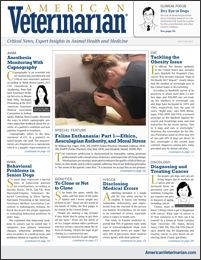Letter to the Editor (October 2017)
A letter from one reader regarding a previous article on veterinary chiropractic care.
Dear Editor:
I am very concerned that you are helping to spread bad medical information in the veterinary community through your recent article, “The Benefits of Chiropractic Care” (August 2017). Chiropractic for animals is one of the ways pseudo-medicine is making its way into veterinary school curricula. The author attempts to explain the history of chiropractic while avoiding the reality: The entire theory of chiropractic is based on the idea that all disease is based on “vertebral subluxation.” The problem is that vertebral subluxation is not a real diagnosis; in over 100 years of existence, the “science” of chiropractic has never been able to demonstrate it. Multiple chiropractors examining the same patient can’t even agree on which part of the spine the “subluxation” lies. The belief that it exists leads to the idea that it affects an entire range of medical conditions that have nothing at all to do with vertebrae or spinal nerves.
Many veterinary chiropractors claim to treat a huge range of medical conditions while at the same time denying the efficacy of vaccinations and pharmaceuticals. They promote homeopathy, in which a substance is diluted to the point that not even one molecule of it is detectable, but the water “retains the memory” of the active ingredient. This is also pseudoscience and has been called out as such by many medical and veterinary associations around the world. Even Dr. Peyton’s use of Chinese herbs should be viewed critically, since the production of those herbs is entirely unregulated and has been demonstrated to be rife with fake ingredients and outright lies. With the cost of a veterinary education increasing by leaps and bounds, we should not be spending money teaching unproven and unregulated therapies to veterinary students.
As is typical of articles that glowingly describe chiropractic, this one is full of anecdotes and light on evidence. The latest Cochrane review of chiropractic clearly demonstrates that chiropractic shows no benefit at all for anything other than back pain, and even those results can be achieved by a good physical therapist or massage therapist.1 Just because pet owners ask for it, and it’s gaining in popularity, does not mean it has any medical validity.
Deborah Cottrell, DVM
West End Animal Hospital
Newberry, FL
Reference:
- Rubinstein SM, Terwee CB, Assesdelft WJ, de Boer MR, van Tuider MW. Spinal manipulative therapy for acute back pain: an update of the Cochrane review. Spine. 2013;38(3):E158-177. doi: 10.1097/ BRS.0b013e31827dd89d.
Author Response:
Veterinary medicine has a long history of incorporating therapeutic modalities first developed for humans, and chiropractic is no different. Is chiropractic appropriate for all conditions? Of course not—no treatment is. But it does the profession a disservice to dismiss chiropractic out-of-hand. Anecdotal evidence and studies in humans show that chiropractic is effective for a variety of issues, and understandably more and more veterinarians are looking into it for their patients. Rather than ignoring chiropractic, veterinarians should demand greater study into its effectiveness on their patients. Only then can its usefulness be fully determined.
—Don Vaughan
